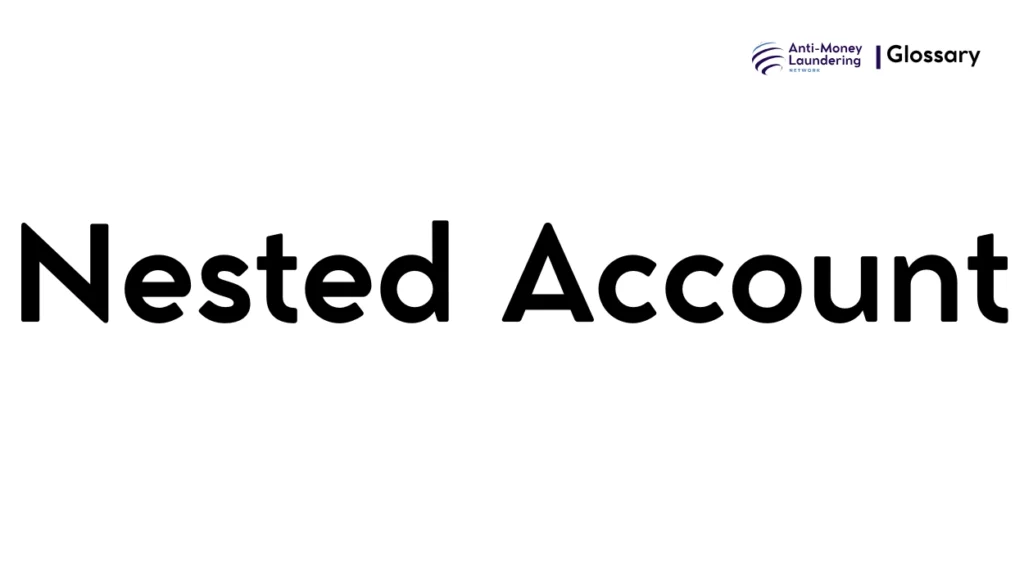Definition
A Nested Account in AML refers to an arrangement where a foreign financial institution accesses the services of another bank (often a correspondent bank) through an intermediary financial institution’s account, rather than holding a direct account itself. This results in the intermediary acting as a conduit, allowing the nested institution to conduct transactions and access financial systems indirectly, often obscuring the true origin or destination of funds.
Purpose and Regulatory Basis
Nested accounts play a significant role in expanding financial access, especially for smaller or regional banks lacking direct correspondent relationships. However, this arrangement raises concerns in AML compliance because it can obscure transaction transparency and complicate risk assessment.
Globally, regulatory bodies like the Financial Action Task Force (FATF), USA PATRIOT Act, EU Anti-Money Laundering Directives (AMLD), and national regulators require enhanced due diligence to manage the risks associated with nested accounts. These frameworks emphasize that institutions must understand the relationships and flows within nested structures to prevent money laundering and terrorist financing.
When and How It Applies
Nested accounts arise typically when:
- A foreign bank gains access to another country’s financial system through a correspondent bank’s account.
- Payment service providers offer downstream clients access to payment services via their own accounts, sometimes without full disclosure.
For example, a small bank in an emerging market might use an intermediary bank’s correspondent account in the U.S. to facilitate international transactions, effectively nesting inside the correspondent’s banking structure.
Types or Variants
- Downstream Correspondent Banking: This classic type involves foreign banks operating through the correspondent banking relationship of another bank.
- Payment Provider Nesting: Where a payment platform customer offers payment services to its own clients without properly onboarding or disclosing them, creating hidden layers.
Procedures and Implementation
Financial institutions must implement:
- Customer Due Diligence (CDD): Identify and verify not only direct customers but also any nested entities.
- Enhanced Due Diligence (EDD): Applied when nested relationships are found, especially where risk is elevated.
- Transaction Monitoring: Real-time scrutiny to detect unusual or high-risk activity within nested accounts.
- Contractual Agreements: Define responsibilities and restrictions explicitly between correspondent and respondent banks.
Technology systems should incorporate flags for nested relationships and ensure transparency of the underlying parties involved in transactions.
Impact on Customers/Clients
From the customer’s perspective, nesting can introduce:
- Additional scrutiny and verification steps.
- Possible restrictions on transactions due to risk management.
- Transparency challenges, as the true identity of downstream beneficiaries or payers may be obscured.
Financial institutions must balance compliance needs with maintaining customer rights and service quality.
Duration, Review, and Resolution
Nested account relationships require:
- Ongoing Monitoring: Regular risk assessments and transaction reviews.
- Periodic Reviews: To confirm that AML controls remain effective and to update customer information.
- Resolution Mechanisms: Possible termination or remediation if risks are unmanaged or suspicious activities are detected.
Reporting and Compliance Duties
Institutions must document:
- All nested account relationships with clear evidence.
- Enhanced due diligence steps taken.
- Suspicious activity reports when warranted.
Failure to comply can lead to severe penalties, reputational damage, and regulatory sanctions.
Related AML Terms
- Correspondent Banking: The base relationship enabling nested accounts.
- Enhanced Due Diligence (EDD): Heightened scrutiny required for nested structures.
- Beneficial Ownership: Identifying true owners behind accounts.
Challenges and Best Practices
Challenges
- Lack of Transparency: Difficulty tracing the end user behind transactions.
- Regulatory Complexity: Varying rules across jurisdictions.
- Operational Burden: Monitoring nested accounts requires advanced systems and trained staff.
Best Practices
- Require full disclosure of nested relationships upon onboarding.
- Use risk-based approaches tailored to nested risks.
- Deploy advanced transaction monitoring tools capable of recognizing nested activity.
- Implement strict contractual terms clarifying AML responsibilities.
Recent Developments
Recent AML regulatory updates, such as those by AUSTRAC and FATF, have started formally recognizing nested services as a distinct risk requiring enhanced measures. Technology advances now offer better detection and real-time monitoring, aiding compliance. Some providers have banned nested accounts outright, choosing structured alternatives like affiliate programs to mitigate risks.
Nested accounts are a crucial but complex feature of international banking that facilitates access but heightens AML risks due to obscured transparency. Compliance officers must employ enhanced due diligence, rigorous monitoring, and clear contractual frameworks to manage these risks effectively, aligning with global regulations to prevent money laundering and terrorist financing.

